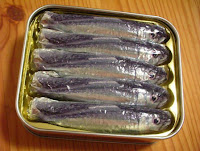What is Canning?
Canning is a method of preserving food in which the food is processed and sealed in an airtight container, providing a typical shelf life ranging from 1 year to 5 years and under specific circumstances a freeze dried canned product can last as long as 30 years and can still be safely consumed. The process was first developed as a French military discovery by Nicolas Appert in 1810. The packaging prevents microorganisms from entering and proliferating inside.
The Principles of Canning
The purpose of thermal processing during manufacture of canned fishery products is the destruction of bacteria by application of moist heat. Only having satisfied the safety requirements of protecting consumer health, and the commercial requirements of preventing non-pathogenic spoilage, does the canner set about choosing a thermal process schedule that will optimise the sensory quality of the finished product.
 |
| Canned fish |
The Principles of Canning
The purpose of thermal processing during manufacture of canned fishery products is the destruction of bacteria by application of moist heat. Only having satisfied the safety requirements of protecting consumer health, and the commercial requirements of preventing non-pathogenic spoilage, does the canner set about choosing a thermal process schedule that will optimise the sensory quality of the finished product.
Of the bacteria contaminating fishery products, some (the pathogenic bacteria) cause food poisoning while others only spoil the food. Of particular concern to fish canners is the possibility of there being contamination by Clostridium botulinum which, if present, can form heat resistant spores capable of withstanding a mild thermal process. As this micro organism can grow at the pH of fish flesh it is important that the processor ensure that all his cans have received a process that is sufficiently severe to kill spores and vegetative forms of the bacterium. Survival of Clostridium botulinum, after the thermal process, is an extreme health risk as low-acid canned foods (pH > 4.5) support growth of the organism, and under certain conditions will also favour formation of the neurotoxin responsible for outbreaks of botulism.
Sterilization is a heat treatment given foods capable of supporting the growth of heat resistant spore forming bacteria. Sterilization processes destroy all pathogenic contaminants and all other micro organisms capable of growing under normal storage conditions; survivors of the process will be extremely heat resistant spores which pose no health risk and only grow at elevated temperatures (= 40 ºC). Rather than make canned foods absolutely sterile, canners aim for "commercial sterility" which means that the contents are safe (as all pathogenic microorganisms have been destroyed) and shelf-stable at normal storage temperatures. Were the thermal process designed to make all cans absolutely sterile, there would be unnecessary loss of sensory and nutritional quality without there being any increase in the safety of the product.
The higher the temperature of sterilization the greater is the rate of thermal destruction, which is why canners process their canned fish in steam under pressure rather than in water at atmospheric pressure. The rate of thermal destruction is also affected by the nature of the product (liquids heat faster than solids) and the container size (large cans of fish packed in brine take longer to reach lethal temperatures, than do small cans containing the same product). The total sterilization effect of a thermal process can be expressed as the sum of all the sterilization effects achieved by all the time-temperature combinations throughout the entire thermal process. By convention, sterilizing effect is expressed in standard units of minutes at 121.1 ºC, so that. an entire processing cycle is expressed as being equivalent, to holding the product at 121.l ºC for a given time. The unit of sterilization is the Fo unit, where an Fo value of one minute is equivalent to holding the product at 121.1 ºC for one minute and then cooling it instantly.
PAGE 1 - 2 - 3 - 4 - 5 - 6 - 7

No comments:
Post a Comment